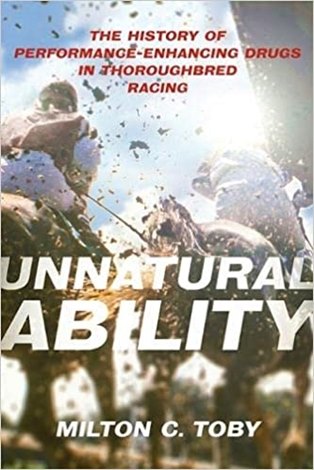Author Toby: HISA May be Racing’s Last, Best Chance

As horse racing continues to make the transition from state-to-state regulation of medication and anti-doping to oversight by the Horseracing Integrity and Safety Authority (HISA), an upcoming book by Milt Toby certainly is well-timed.
In “Unnatural Ability: The History of Performance-Enhancing Drugs in Thoroughbred Racing,” the former BloodHorse writer and photographer (1973-1985) looks at the industry’s medication and doping issues from a historical perspective, providing the reader a greater understanding of today’s challenges.
In April Toby and BloodHorse editorial director Frank Angst discussed the book—his 10th on racing or legal issues related to racing—the medication and doping problem, and possible solutions.
BH: What were the reasons you wanted to write this book?
MT: When I’m looking for a topic to write about, whether it’s an article or book, I try to find something that people think they already know but they really don’t. That’s the goal with the book about Shergar (“Taking Shergar: Thoroughbred Racing’s Most Famous Cold Case“). That was really the goal with the book here too.
With “Unnatural Ability,” it really started back in 1968. I was in college and that was the first Kentucky Derby I ever attended in person. A group of us from Centre (College) were out in the infield and I saw little bits of horses running by and I’d bet on Forward Pass. I was stunned in a few days to see the headlines (that first-to-the-finish Dancer’s Image had failed a post-race drug test). And then I didn’t give it any more thought, or very little conscious thought, until I started doing other stuff. After I left BloodHorse I lived overseas for six years doing freelance news photography, then I came back and went to law school and practice for 25 years. And then I started teaching at (the University of Louisville). But all of this revolved around racing in some fashion. And it all went back to Dancer’s Image’s Derby.
The book I wrote about that, (Dancer’s Image, the Forgotten Story of the 1968 Kentucky Derby) won the Dr. Tony Ryan Book Award. Then I’ve been intrigued by Shergar ever since. He was stolen about the time I was getting ready to leave the BloodHorse.

BH: So some topics that kind of gripped you that you wanted to tell more about have led to books?
MT: It’s the same with medication. I think people who haven’t been around long enough to know any different, they look at the Jorge Navarro and Jason Servis indictments, they look at the Medina Spirit Derby disqualification, and they think this is a new big deal. And it is a big deal. But, it’s not even close to being new.
That is why I wanted to start this book. I couldn’t find any concise history of performance-enhancing drugs in racing. I got a lot of encouragement from the Keeneland Library folks, and BloodHorse, and there we are. It seemed like a really good idea at the time.
BH: As you said, these latest scandals, unfortunately, they’re nothing new in U.S. horse racing. Can you talk about some of the incidents you found and how this has been a recurring problem for the sport?
MT: That’s what I wanted people to understand about all this; it’s been a recurring problem. The tricky thing is, it still isn’t clear to me whether the medication issue is actually an issue that needs to be dealt with, or whether it’s a PR issue that needs to be managed. I’m just not sure on that.
And the other question is whether or not there’s a doping culture in racing. I think there is. Then, it’s a question of how you define a doping culture. You look at cycling. Somebody was asking a two-time Tour de France winner about a doping culture. And he said, ‘Basically, a doping culture is you have a positive test.’ You have a big star with a positive test, everybody raises a lot of hell about it, and then everybody forgets.
What I would like to know is if I were to get a group of horsemen together and ask them when they heard about the (Navarro-Servis) indictments, if they were surprised. I would wager that they weren’t surprised. Still, I just don’t know the scale.
BH: I think one thing your book really brings to light is that while doping in any sport is terrible for the integrity of the sport, in horse racing doping is both a terrible integrity issue but also can endanger the horse. Can you talk about those equine welfare concerns through history?
MT: The first example I could find of an elite athlete dying because of presumably being doped was around the turn of the 19th to 20th century. He was a professional bicycle racer and he collapsed. And everybody said he had amphetamines in the pocket of his jersey, but that was never confirmed. But that sort of set the stage. When you talk about doping culture, there clearly is that in cycling. It’s better now but clearly there’s been a problem. If you read the (United States Anti-Doping Agency’s) reasoned decision about Lance Armstrong, it’s fascinating reading.
A big difference in the doping everywhere else and the doping in horse racing is that the athletes in cycling or track or football or baseball are the stakeholders. They’re the people who are doping. I think the horses are stakeholders in racing, and they don’t have any control or any say over what’s happening to them. And that’s what really bothers me.
BH: I think it’s safe to say that HISA got a lot of its support in Congress because of this equine welfare concern that’s tied to doping and medication issues.
MT: I think you’re right, that and Churchill Downs finally changing its position and Sen. (Mitch) McConnell getting behind it. But yes, I think welfare was a big part of it.
BH: Do you think a sport that has this problem can come back from scandal by improving its testing and integrity efforts? You think of some of the doping scandals in cycling, track and field, swimming, and other sports?
MT: I don’t know the answer to that. I think it depends on how you manage it. My personal view is that when it comes to racing, HISA is its last best chance to fix this. If the lawsuits finally throttle HISA, I think racing will largely go away other than the big-event days. The Triple Crown races aren’t going to go away. Breeders’ Cup isn’t going to go away, but the little tracks are going to go away. And if HISA doesn’t work, I don’t know what else you can do.
BH: Can you talk about the way the sport has been regulated and how that has changed through the years?
MT: The American Jockey Club was founded in 1894. And fairly quickly, they enacted a rule that said that you couldn’t stimulate a horse. But they had no way to enforce it because there was no testing in the 19th century. In the early part of the 20th century the British Jockey Club did the same thing; they passed a rule that said you can’t use stimulating drugs. And there was no test then either. So you had an attempt to regulate it at the industry level around the turn of the century.
It wasn’t until 1934, when a saliva test was introduced to the U.S., that there was a way to actually know that a horse had been doped. Until you had that test, nothing ever happened. … What’s ironic is that the saliva test that we started using here in 1934, at Hialeah Park, was developed in 1910 in Europe. It just started in Europe. It didn’t come here for 24 years. I wonder what would have happened if it had been imported sooner.
The book talks at length about a raid by the Federal Bureau of Narcotics. That raid was a few months before the saliva test was introduced. What was really interesting about that, and what I suspect will be one of the more controversial parts of the book, is that in the back of the book in one of the appendices is a list of recipes that the federal agents collected while they were going around doing their undercover investigation. There’s like 45 of them. And the thing is, a good many of them were morphine and caffeine and cocaine, sometimes opium. They were the very same drugs that people were using in the 1890s. So nothing changed until there was a test.
That’s why I think the testing part of HISA is so important and I don’t think that the post-race testing is going to be the most important part of HISA (compared with investigations and out-of-competition testing).
BH: How did the state-to-state regulation arrive in racing?
MT: They were protecting the gamblers, because that’s where the money comes from (for the industry).
BH: Do you think that the state-to-state regulation has held the sport back in any way?
MT: I don’t know enough about it, but I do know that it’s the investigation part of the (anti-doping) process that is needed (and not happening under the state oversight). Three or four years ago, maybe longer, (Team Valor CEO) Barry Irwin wrote an article that said post-race testing doesn’t solve the problem. It’s the investigation work that does, and then you use the pre-race testing or post-race testing to verify the investigation.
BH: And that’s what we potentially can have with HISA. Is that one of the reasons you think HISA is kind of a last stand for the sport on this issue?
MT: I really do. When Harry Anslinger and the Federal Narcotics Bureau were going into their undercover investigations (in the early 1950s), there was a push then for federal involvement in the sport. And Harry Anslinger, who was the commissioner of narcotics, threatened racing with federal involvement if it didn’t fix the problems. Neither of those things happened. Anslinger lost interest; he was more interested in marijuana and opium coming into the country. And so there was never a push again for federal regulation until the last decade really.
BH: In the May issue of BloodHorse you had a terrific story on the use of smart testing—using investigative work to target potential rule-breakers. This is the area you see HISA as being better positioned to carry out than the states.
MT: The idea with targeted testing is to identify likely dopers; trainers who are more likely to use (performance-enhancing drugs). The investigation is the important part because then you know who to look at with the testing. If you know who to look at, then you can do more testing there—you’re out-of-competition testing, maybe pre-race testing, certainly post-race testing.
With the targeted testing that HISA is talking about, you are identifying the players. The post-race testing is really important but post-race testing is only identifying an event. There isn’t really any thought or there isn’t much thought. Random testing isn’t targeted at all, it’s random.
Looking at other sports, in the BALCO scandal (anabolic steroids in baseball), they got confessions from people without testing at all really. There was very little analytical testing. And there was almost no analytical testing of Lance Armstrong and cycling. So that shows me that post-race testing is important, but it’s not the be all and end all. It’s the investigations that that will pay off. With Lance Armstrong they took away his seven Tour de France wins without any positive tests. It was all analytical evidence and testimony from his friends and rivals.
BH: Taking that idea to horse racing, on the indictments of Jorge Navarro and Jason Servis and some 30 people, those were generated by investigations, not by post-race testing.
MT: Not at all. And it also says something about the resources of state racing commissions. I don’t want to say they don’t know how to investigate, but they don’t have the resources.
BH: And operating in this environment, Navarro and Servis were able to win a lot of races, a very high percentage of races at tracks where they were based, all while having many of their horses subjected to post-race testing.
MT: Exactly. And that’s the fall here. You can’t rely on one part of the equation. Post-race testing is important but in Dancers Image’s Derby, Forward Pass was moved up eventually but he was never tested for drugs.
BH: Wow, so Forward Pass benefited but didn’t face the same post-race scrutiny as the winner. That’s another problem with random testing.
Do you think horsemen—and I say horsemen because they’re the ones that by definition are responsible for the condition on the horse—do you think most horsemen today realize the stakes involved in this aspect of the sport? Do they realize this is a sport that really can’t handle many more scandals in terms of what the public will tolerate?
MT:I think they realize it on some level. But I think unless it affects them personally, they’re not going to be activists.
BH: Which brings us back to the need for effective oversight, which we agree needs to involve investigations.
MT: That’s been the case. You look at the Silent Tom Smith suspension (Smith, of Seabiscuit fame, was suspended by The Jockey Club for a year in the mid-1940s). He was suspended not on the basis of any positive drug tests at all. He was suspended on the basis of people seeing that his horses were being given something. And they examined some of the containers and found ephedrine.
BH: And at the time he was about as well known as any trainer.
MT: Yes, and he was convicted with no analytical testing at all. And the question was not whether he had administered the drugs, because basically he admitted that he had used it for his own nasal congestion and thought it would help the horse. But the question it all boiled down to in the final hearings was whether ephedrine could have affected the outcome of a race. Ephedrine was a banned drug in the 40s and still is. But the rule at the time was talking about whether a drug affected the outcome, not whether it had the potential to affect the outcome. And so they had experts on both sides arguing that it certainly could have because it’s a stimulant, and other people saying well, no, it won’t because we did test it in horses and couldn’t tell the difference at all.
So it was almost a question of how the rule was written. And they finally wound up suspending him. His appeals eventually fell apart. (And the process was not drawn out.) The idea then was justice delayed is justice denied.
(Today) by the time a medication positive now is actually resolved, if the trainer goes through all the appeal steps—the administrative hearings then into court appeals—it can be two to three years maybe before you find out what happened. The event is two or three years in the past and then you’ve forgotten about it.
That’s one of the real problems (of the current state regulatory oversight) that I think HISA may be able to solve.




